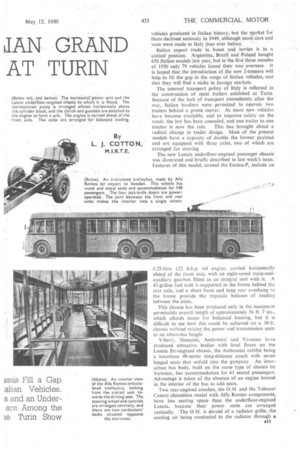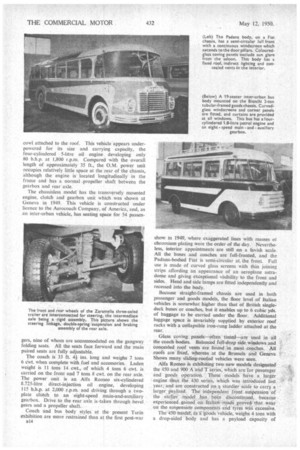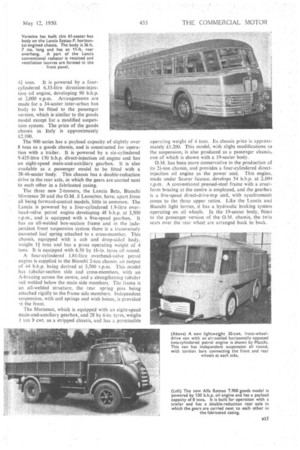AN IT SLA !IAN GRAN AT TURIN
Page 46

Page 47

Page 48

Page 49

If you've noticed an error in this article please click here to report it so we can fix it.
ALTHOUGH vehicles manufactured in any part of the world may be exhibited at the International Motor Show at Turin, the second past-war Show, which closes on Sunday, is notable as an all-Italian exhibition of buses, coaches, lorries and trailers. If it were not for the introduction of new chassis, the Show
would be entirely without interest for the British corn _ inercial user.
New Lancia, 0.M, and Bianchi 2-ton forward-control models, and Alfa Romeo 4-tonners and 8-tonners afford the interest in goods vehicles, whilst the Lancia underfloor-engined chassis, the 0 M. rear-engined coach and the Casaro-Alfa Romeo rear-engined chassisless model provide scope for bodybuilders to demonstrate what can be done with out-of-the-ordinary passenger chassis.
News of the new 2-ton range had been kept "tap secret," and the prototypes were covered and no details were released until the opening day of the Show. Apart from local-delivery vehicles, mostly based on car chassis, most Italian commercial vehicles have formerly been heavy models of 4-ton, 7-ton and 10-ton load capacity, equipped with oil engines and operating with trailers Because the price of petrol is much higher in Italy than elsewhere, the heavy oiler has been the only economical means for transport in the country. Immediately after the war all the commercial-vehicle manufacturers started to build these heavy models, and produced passenger chassis on similar lines. The records of 1947 show the highest number of heavy al2 vehicles produced in Italian history, but the market for them declined seriously in 1949, although more ears and vans were made in Italy than ever before.
Italian export trade in buses and lorries is in a• critical position. Argentina, Brazil and Poland bought 656 Italian models last year, but in the first three months of 1950 only 79 vehicles found their way overseas lt is hoped that the introduction of the new 2-tormers will help to fill the gap in the range of Italian vehicles, and that they will find a niche in foreign markets.
The internal transport policy of Italy is reflected in the construction of most trailers exhibited at Turin. Because of the lack of transport immediately after the . war, Italian hauliers were permitted to operate two trailers behind a prime mover. As more new vehicles . have become available, and to improve safety on the roads, the law has been amended, and one trailer to one tractor is now the rule. This has brought about a radical change in trailer design. Most of the present models have a capacity of double the former payload and are equipped with three axles, two of which are arranged for steering The new Lancia underfloor-engined passenger chassis was illustrated and briefly described in last week's issue. Features of this model, termed the Esatau-P, include an
8.25-litre 122 b,h.p. oil engine, carried horizontally ahead of the front axle, with an eight-speed main-andauxiliary gearbox fitted as an integral unit with.it. A 45-gallon fuel tank is supported in the frame behind tha rear axle, and a short front and long rear overhang to the frame provide the requisite balance of loading between the axles.
This chassis has been produced only in the maximum permissible overall length of approximately 36 ft. 7 ins., which affords scope for balanced loading, but it is difficult to see how this could be achieved on a 30-ft. chassis without raising the power and transmission units to an abnormal height, Viberti, Menarini, Ambrosini a,nd Varesina have produced attractive bodies with level floors on the Lancia flat-engined chassis, the Ambrosini exhibit being a luxurious 48-seater long-distance coach with seven hinged seats that unfold into the gangway. An interurban bus body, built on the same type of chassis by Varesina, has accommodation for 61 seated passengers. Advantage is taken of the absence of an engine bonnet in the interior of the bus to add seats.
Two rear-engined coaches, the O.M. and the Tubocar Casaro chassisless model with Alfa Romeo components, have less seating space than the underfloor-engined Lancia. because their power units are arranged vertically. The O.M. is devoid of a radiator grille, the cooling air being Conducted to the radiator through a
cowl attached to the roof. This vehicle appears underpowered for its size and carrying capacity, the four-eylindered 5-litre oil engine developing only 80 bh.p. at 1,800 r.p.m. Compared with the overall length of approximately 35 ft., the O.M. power unit occupies relatively little space at the rear of the chassis, although the engine is located longitudinally in the frame and has a normal ,propeller shaft between the gearbox and rear axle.
The chassisless model has the transversely mounted engine, clutch and gearbox unit which was shown at Geneva in 1949. This vehicle is constructed under licence to the Aerocoach Company, of America, and, as an inter-urban vehicle, has seating space for 54 passen gers, nine of whom are accommodated on the gangway folding seats. All the seats face forward and the main paired seats are fully adjustable.
The coach is 33 ft. 41 ins, long and weighs 7 tons 6 cwt. when complete with fuel and accessories. Laden weight is 11 tons 14 cwt., of which 4 tons 6 cwt. is carried on the front and 7 tons 8 cwt. on the rear axle. The power unit is an Alfa Romeo six-cylindered 8.725-litre direct-injection oil engine, developing 115 b.h.p. at 2,000 r.p.m. and driving through a twoplate clutch to an eight-speed main-and-auxiliary gearbox. Drive to the rear axle is taken through bevel gears and a propeller shaft. • Coach and bus body styles at the present Turin exhibition are more restrained than at the first post-war show in 1949, where exaggerated lines with masses of chromium plating were the order of the day. Nevertheless, interior appointments are still on a lavish scale. All the buses and coaches are full-fronted, and the Padana-bodied Fiat is semi-circular at. the front. Full use is made of curved glass screens with thin joining strips affording an appearance of an aeroplane astradome and giving exceptional visibility to the front and sides. Head and side lamps are fitted independently and recessed into the body.
Because straight-framed chassis are used in both passenger and goods models, the floor level of Italian vehicles is somewhat higher than that of British singledeck buses or coaches, but it enables up to 6 cubic yds. of baggage to be carried under the floor. Additional luggage space is invariably supplied by exterior roof racks with a collapsible iron-rung ladder attached at the rear.
Glass coving panels—often tinted—are used in all the coach bodies. Balanced full-drop side windows and Concealed roof vents are found in most coaches. All roofs are fixed, whereas at the Brussels and Geneva Shows many sliding-roofed vehicles were seen.
Alfa Romeo is exhibiting two new models designated the 450 and 900 Nand T series, which are for passenger and goods operation. " These . models have a larger engine thanthe 430 series, which was introduced last year; and are constructed on a sturdier scale to carry a larger. Paylload. The independent front suspension of the earlier, model has been discontinued, -because experienced gained on Italian roads proved that Wear on the suspension' components and tyres was excessive. The 450 Model, gs a: goods vehicle, weighs :4 tons with a drop-sided body and has a payload capacity of ,=Vi tons. It is powered by a four cylindered 6.33-litre direction-injection oil engine, developing 90 b.h.p. at 2,000 r.p.m. Arrangements are made for a 34-seater inter-urban bus body to be fitted to the passenger version, which is similar to the goods model except for a modified suspension system. The price of the goods chassis in Italy is approximately £2,100.
The 900 series has a payload capacity of slightly over 8 tons as a goods chassis, and is constructed for operation with a trailer: It is powered by a six-cylindered 9.435-litre l30 bit.p. direct-injection oil .engine and has an eight-speed main-and-auxiliary gearbox. It is also available as a passenger model to be fitted with a 38-46-seater body: This chassis has a double-reduction drive in the rear axle, in which the gears are carried next to each other in a fabricated casing.
The three new 2-tonners, the Lancia Beta, Bianchi Sforzesco 20 and the 0.M. il Leoncino, have, apart from all being forward-control models, little in common. The Lancia is powered by a four-cylindcred L9-litre overhead-valve petrol engine developing 48 b.h.p. at 3,500 r.p.m.; and is equipped with .a five-speed gearbox. It has an all4velded box-section frame and in the independent front suspension system there is a transversely mounted leaf spring attached to a cross-member. This chassis, equipped with a cab and drop-sided body, weighs l tons and has a gross operating weight of 4 tons. It is equipped with 6.50 by 16-in tyres all round.
A four-cylinclered 1.81-litre overhead-valve petrol engine is supplied in the Bianchi 2-ton chassis. an output of 44 kh.p. being derived at 3,500 r.p.m. This model has tubular-section side and cross-members, with an A-bracing across the centre, and a strengthening tubular rail welded below the main side members. The frame is an all-welded structure, the rear spring pins being attached rigidly to the frame side members. Independent suspension, with coil springs and wish bones, is provided 'It the front.
The Sforzesco, which is equipped with an eight-speed main-and-auxiliary gearbox, and 28 by 6-in. tyres, weighs 1 ton 9 cwt. as a stripped chassis, and has a permissible operating weight of 4 tons. Its chassis price is approximately £1,200. This model, with slight modifications to the suspension, is also produced as a passenger chassis, one of which is shown with a 19-seater body.
O.M. has been more conservative in the production of its 2q-ton chassis, and provides a four-cylindered directinjection oil engine as the power unit. This engine, made under Saurer licence, develops 54 b.h.p. at 2,100 r.p.m. A conventional pressed-steel frame with a cruciform bracing at the centre is employed, and the gearbox is a fire-speed direct-drive-top unit, with synchromesh cones to the three upper ratios. Like the Lancia and Bianchi light lorries, it has a hydraulic braking system operating on all wheels. In the 19-seater body, fitted to the passenger version of the 0.M. chassis, the twin seats over the rear wheel are arranged back to back.




























































































